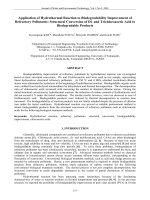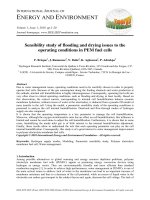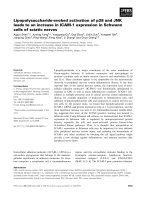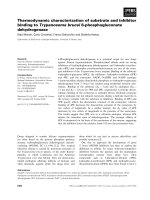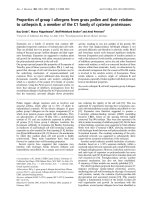Response of pulse and oilseed crops to boron application: A review
Bạn đang xem bản rút gọn của tài liệu. Xem và tải ngay bản đầy đủ của tài liệu tại đây (182.3 KB, 7 trang )
Int.J.Curr.Microbiol.App.Sci (2018) 7(3): 669-675
International Journal of Current Microbiology and Applied Sciences
ISSN: 2319-7706 Volume 7 Number 03 (2018)
Journal homepage:
Review Article
/>
Response of Pulse and Oilseed Crops to Boron Application: A Review
Sunil Kumar1, Mamta Phogat2* and Manohar Lal3
1
Department of Soil Science and Agricultural Chemistry, 3Department of Agronomy, College
of Agriculture, SKRAU, Bikaner – 334006, India
2
CCS Haryana Agriculture University, Hisar-125004, Haryana, India
*Corresponding author
ABSTRACT
Keywords
Boron, Legume, Oil
seeds
Article Info
Accepted:
07 February 2018
Available Online:
10 March 2018
The occurrence of micronutrient deficiencies in crops has increased markedly in recent
years due to intensive cropping, soil erosion, leaching, liming of acid soils, reduced use of
manures, increased purity of chemical fertilizers and use of marginal lands for crop
production. Among the micronutrients, the boron plays an important role in flowering and
fertilization process and hence boosting yield and quality of crop produce. Response of
legume crops to boron application suggested that boron deficiency drastically reduced
nodulation, growth and yield of legumes because of inadequate supply of carbohydrates to
bacteria in the root nodules and insufficient conversion of starch to soluble sugars.
Application of boron also markedly increases yield and quality of oil seed crops. The
literature on the significance of Boron in growth as well as physiological functions of
pulses and oil seed crops have been reviewed and presented.
deficient in B spreading over wide area, and
particularly in alluvial soils (Sakal and Singh,
1995; Singh, 2008). Its deficiency has been
reported to the tune of 5-10% in soils of
Punjab (Bansal et al., 2003; Singh and
Nayyar, 1999). In general, deficiencies of B
are prominent in soils of light texture and
high pH, and in areas of heavy rainfall, dry
weather and high intensity of light. The
magnitude of response of B application varies
widely from crop to crop, varieties within a
crop and on different soils for the same crop.
The soils with high initial available boron
produce lower yield response or no or even
negative response to application. As the range
between boron deficiency and toxicity is also
Introduction
Boron is an essential micronutrient
indispensable for the normal growth and
development of plants. It plays an important
role in flowering and fertilization process,
boosting yield and quality of crop produce
(Kanwar and Randhawa, 1974). It is
recognized as one of the most commonly
deficient micronutrients in soils as its
deficiency has been reported in 132 crops
over 80 countries (Shorrocks, 1997). The
deficiency of boron in soils is a major cause
of crop yield reduction in China, India, Nepal,
and Bangladesh (Anantawiroon et al., 1997).
In Indian, about one third of the soils are
669
Int.J.Curr.Microbiol.App.Sci (2018) 7(3): 669-675
very narrow, therefore, it needs to be applied
cautiously (Sakal et al., 1999). Horticultural
crops require more B than crucifers followed
by the legumes and cereals the least,
accordingly the response to B application in
crops follows the order of horticultural crops
> crucifers > legumes > cereals (Ranade,
2009).
but its application above this level proved to
be detrimental while in coarse textured highly
calcareous soils, application of 2.0 and 2.5 kg
B ha-1 resulted in an increase in grain yield of
black gram and chickpea by 33 and 38 per
cent, respectively (Sakal et al., 1988). A
reduction in seed yield of black gram up to
40-50 per cent as a result of boron deficiency
in soils with hot water soluble boron content
(HWS-B) of 0.12-0.14 mg B kg-1 has also
been reported (Rerkasem et al., 1988).
Similarly, in boron deficient soils of Thailand
a reduction in yield of black gram has been
reported upto 70 per cent and while in green
gram by 21 per cent (Rerkasem, 1991).
Positive responses of pulses crops to B
application (0.5 to 2.5 kg B ha-1) have been
largely reported from Bihar, Orissa, West
Bengal, Assam, and Punjab (Takkar et al.,
1997). The genotypes of a crop either
susceptible or tolerant to B helps in
determining the rate and method of boron
application to enhance the crop yield (Ceyhan
and Onder, 2007). Interaction of B with other
nutrients may take place in soils and/or in
plants. Interactions may lead to the increased
availability (synergistic) or adversely affect
the availability (antagonistic) of those
nutrients (Sakal et al., 1988). Temperature as
an abiotic factor plays an important role. At
chilling temperature, B uptake, transport and
partitioning into growing shoots are strongly
impaired, and B use efficiency in the growing
tissues is reduced (Ye, 2004). Hence, boron
plays an important role in growth and
development of higher plants, especially,
horticulture crops, crucifers and legumes.
Response of
application
legume crops
The grain yield of green gram was found to be
significantly increased by application of
boron, however, early growth of the crop in
soils on low boron contents is depressed
because of the large percentage of abnormal
seedling but increasing boron content of the
soil to 0.36 mg B kg-1 eliminates any such
abnormal seedlings regardless of the seed
boron content (Rerkasem et al., 1990). In
black gram, symptoms of boron deficiency
were observed as chlorosis of leaf margins,
inhibited floral development, brittleness,
shortened internodes and reduced pod set
which were similar to those as reported in
black bean (Howeler et al., 1978). The
symptoms were corrected by an application of
4 kg borax ha-1. In addition, the boron
application also increased pod set and seed
yield. Boron application increased dry matter
yield and concentration of B in white clover
and lucerne grown on silty loam soils of New
Zealand with pH 5.9 and available boron
content 0.28 ppm (Sherrell, 1983a; Sherrell,
1983b).
to boron
It has been observed that deficiency of boron
drastically reduces nodulation, growth and
yield of legumes due to insufficient supply of
carbohydrates to bacteria in the root nodules
and inadequate conversion of starch to soluble
sugars (Brenchley and Thornton, 1925;
Walter et al., 1982; Tripathy et al., 1999).
Dear and Lipsett (1987) reported in cerealclover
rotation,
herbage
yields
of
subterranean clover increased by 25 per cent
with application B but seed yield increased
21-fold with B application. Increasing levels
Application of 1 kg B ha-1 has been reported
to produce an additional pod yield of 7.38 q
ha-1 in French bean (Singh and Singh, 1990),
670
Int.J.Curr.Microbiol.App.Sci (2018) 7(3): 669-675
of boron increased dry matter yield of
berseem up to 2 ppm. Thereafter, yield
decreased with higher doses of boron
application (Pal et al., 1989). Prakash and
Dey (1997) reported that black gram sprayed
with 0, 0.01 per cent, 0.02 per cent or 0.03 per
cent B solutions (as borax) had a positive
effect on crop in field trials in kharif season.
Ceyhan and Onder (2007) studied the effect
of boron on yield and yield components of
five chickpea (Cicerarietinum) genotypes,
namely Akc, in-91, Population, Go"kc,e,
I’zmir-92, and Menemen-92 in calcareous
soils in central Anatolian Turkey. They
observed that grain yields in all genotypes
(except for Go”kc.e) were significantly
increased by 1 kg ha-1 B application.
Genotypes studied showed significant
variations with respect to their responses to
additional B. Dixit and Elamathi (2007)
reported that foliar application of boron (0.2
per cent) in green gram increased the plant
height, number of nodules plant-1, dry weight
plant-1 and number of pods plant-1, 1000-seed
weight, grain yield and haulm yield over the
control. Harmankaya et al., (2008) observed
that the yield loss in common bean
(Phaseolus vulgaris L.) was due to boron
deficiency when the susceptible cultivars
were grown in calcareous boron deficient
soils. The yield was obtained higher in boron
applied genotypes (Sehirali-90, Yunus-90,
Karacasehir-90, Onceler-90, Goyniik-98 and
Akman-98) than control. Applications of soil
and foliar boron increased yield average of 10
and 20 per cent, respectively. Kaisher et al.,
(2010) conducted a field experiment on mung
bean in sandy loamy textured boron-deficient
soil in Bangladesh. They observed that
application of boron at the rate of 5 kg B ha-1
had significant effect on plant height, number
of branches plant-1, number of pods plant-1,
number of seeds pod-1, 1000-seed weight and
seed yield of mung bean seed. Stoltz and
Wallenhammar (2013) studied the effect of
soil and foliar applied boron (B) on flower
development, nectar production, seed yield
and germination in organic red clover was
investigated in B deficient soils. The results
showed that there is a greater increase in seed
yield when B is applied to the soil compared
with foliar application. Among different
treatments, soil applied 0.5 kg ha-1 dose was
reported optimum. Padbhushan and Kumar
(2014) conducted a greenhouse experiment
with green gram grown on boron (B) deficient
calcareous soils was to study the influence of
soil and foliar applied boron on green gram.
The treatments comprised of four levels of
soil applied boron viz. 0.5, 0.75, 1.0 and 1.5
mg B kg-1 and two levels of foliar applied
boron viz. 0.1 and 0.2 per cent borax solution
with common control. It was found that soil
applied boron has more influence on mean
dry matter yield while foliar applied boron
has on mean grain yield. Among all soil
applied boron 0.5 mg kg-1 is best treatment
while 0.1% is best foliar treatment. Soil
applied boron was at the par with foliar
applied boron. Khurana et al., (2012) in a
field study reported that berseem fodder yield
increased significantly in the first and second
cuttings with soil application of 0.75 kg B ha1
. However, significant increase in yield was
obtained in the third cutting with the
application of 1.0 kg B ha-1. Sakal et al.,
(1999) evaluated the direct and residual effect
of varying levels of B on maize-lentil
cropping system through a field experiment
on calcareous soils. It was revealed that
increasing
levels
of
B
application
significantly increased the yield of maize and
lentil up to 16 kg borax ha-1. Lentil was found
to be more responsive to B.
Responses of oilseed crops to boron
application
Application of boron markedly increased
kernel yield and quality of groundnut (Harris
and Gilman, 1957; Harris and Brolman,
1966). However, it was observed that 1.1 kg
671
Int.J.Curr.Microbiol.App.Sci (2018) 7(3): 669-675
B ha-1 in linseed showed a non-significant
increase in grain yield by 0.67-0.74 q ha-1
over control (Chourasia et al., 1992). Sinha et
al., (1991) studied the effect of boron
application on yield of various kharif and rabi
crops and found the increase in the yield of all
the crops. The maximum response was
observed in onion and minimum in lentil
crop. The crops like groundnut, maize and
onion, 2.5 kg B ha-1 was found to produce the
highest yield but for crops such as sweet
potato, Sunflower, mustard and lentil,
application of only 1.5 kg B ha-1 proved to be
beneficial. Malewar et al., (2001) reported
that with increasing levels of borax up to 10
kg Borax ha-1, stover yield increased from
9.47 to 14.41 per cent and seed yield
increased from 6.54 to 10.21 per cent in
mustard. Sarker et al., (2002) observed a
significant variation in respect of yield
components of soybean on a silt loam soil at
different levels of boron. They reported that
boron at the rate of 4.0 kg ha-1 produced
highest plant height and branches per plant.
Boron application at the rate of 1.0 kg ha-1
increased effective pod per plant while boron
at the rate of 2.0 kg B ha-1 produced higher
100 seed weight significantly. Similarly, Ross
et al., (2006) found that there was increase in
the number of plant nodes and plant height in
soybean crop with increasing levels of boron
up to 1.12 kg B ha-1, however, significant
increase was observed up to 0.56 kg B ha-1 of
application.
followed
the
order:
B.
napus>B.
campestris>B. juncea. It was recommended
that different varieties of musturd can grow in
the moderately B deficient soils with a
minimum dose (0.5 kg ha-1) of B application.
In Egypt, Sesame plants were sprayed with
different concentrations of boron solution at
20, 30 and 40 ppm at different stages of plant
growth (1, 2 and 3 months). Treating plants
with boron solution at 20 ppm gave the
highest results in growth criteria as compared
with corresponding control or plants treated
with higher boron solutions (30 and 40 ppm).
The highest oil viscosity was recorded at a
boron concentration of 30 ppm (Hamideldin
and Hussein, 2014).
Prevention and/or correction of B deficiency
in crops on B-deficient soils can have a
dramatic effect on yield and produce quality
of pulse and legume crops. An increase in
yield of 33% in black gram, 38% in Chick
pea, 25% in clover, 20% in common bean,
and 10.21% in mustard was observed with B
fertilization. Both soil and foliar application
methods of B are effective in improving crop
yield.
Acknowledgements
Author would like to thank Dr. V. K. Phogat,
Professor, Department of Soil Science,
CCSHAU, Hisar, for valuable suggestions.
References
Hemantaranjan et al., (2000) observed that
foliar application of boron as boric acid at the
rate of 50 mg kg-1 and 100 mg kg-1 boron on
soybean increased morpho-physiological
attributes, total dry matter production and
seed yield. Hossain et al., (2012) conducted a
field experiment to evaluate the response of
different varieties of B. napus, B.
campestrisand B. juncea to boron application.
Boron application was made at 0 and 1 kg/ha.
The response of the three Brassica species
Anantawiroon, P., Subedi, K. D., and
Rerkasem, B.1997. Screening wheat for
boron efficiency In: boron in soils and
Plants (Eds.) R. W. Bell and B.
Rerkasem.
Kluwer
Academic
Publishers, Dordrecht, Pp. 101-104.
Bansal, R. L., Nayyar, V. K., and Brar J.
S.2003. Available B status of soils in
central plain region of Punjab. Journal
of Research Punjab Agricultural. 40:
672
Int.J.Curr.Microbiol.App.Sci (2018) 7(3): 669-675
172-176.
Brenchley, W. W., and Thornton, H. G. 1925.
The relation between the development
structure and functioning of the nodules
of the Viciafaba, as influenced by the
presence or absence of boron in the
nutrient medium. Proceedings of the
Royal Society of London. Series B,
Biological sciences. 98: 373-398.
Ceyhan, E., and Onder, M.2007. Response of
chickpea cultivars to application of
boron in boron- deficient calcareous
soils. Communications in Soil Science
Plant Analysis. 38: 2381-2399.
Chourasia, S. K., Namdeo, K. N., and
Chaurasia, S. C. 1992. Effect of
nitrogen, Sulphur and boron on growth,
yield and quality of linseed (Linum
usitatissimum). Indian Journal of
Agronomy. 37: 496-499.
Dear, B. S., and Lipsett, J. 1987. The effect of
boron supply on the growth and seed
production of subterranean clover
(Trifolium subterraneum). Australian
Journal of Agricultural Research.
38:537-546.
Dixit, P. M., and Elamathi, S. 2007. Effect of
foliar
application
of
DAP,
micronutrients and NAA on growth and
yield of green gram (Vigna radiata L.).
Legume Research. 30: 305-307.
Hamideldin, N., and Hussein, O. S. 2014.
Response of Sesame (Sesamum indicum
L.) Plants to Foliar Spray with Different
Concentrations of Boron. Journal of the
American Oil Chemists Society.
91:1949–1953.
Harmankaya, M., Onder, M., Hamurcu, M.,
Ceyhan, E., and Gezgin, S. 2008.
Response of common bea (Phaseolus
vulgaris L.) cultivars to foliar and soil
applied boron in boron deficient
calcareous soils. African Journal
Biotechnology. 7: 3275-3282.
Harris, H. C., and Brolman, J. B. 1966. Effect
of imbalance of boron on peanuts.
Agronomy Journal. 58: 97-98.
Harris, H. C., and Gilman, R. L. 1957. The
effect of boron on peanuts. Soil Science.
84: 233-242.
Hemantaranjan, A., Trivedi, A. K., and
Maniram. 2000. Effect of foliar applied
boron and soil applied iron and Sulphur
on growth and yield of soybean
(Glycine max L. MERR). Indian Journal
Plant Physiology. 5: 142-144.
Hossain M. A., Jahiruddin M., and Khatun, F.
2012. Response of mustard (brassica)
varieties
to
boron
application.
Bangladesh Journal of Agricultural
Research. 37(1): 137-148
Howeler, P., Flor, C. A., and Gonzalez, C. A.
1978. Diagnosis and correlation of B
deficiency in beans and mungbeans in
Mollisol from the Cauca Valley of
Columbia. Agronomy Journal. 70:493497.
Kaisher, M. S., Rahman, M. A., Amin, M. H.
A., Amanullah, A. S. M., and
Ahsanullah, A. S. M. 2010. Effects of
sulphur and boron on the seed yield and
protein
content
of
mungbean.
Bangladesh Research Publications
Journal. 3: 1181-1186.
Kanwar, J. S., and Randhawa, N. S.1974.
Micronutrient research in soils and
plants in India: A review. ICAR.
Technical Bulletin (Agric). 50:1-60.
Khurana, M. P. S., Sadana, U. S., Manchanda,
J. S., and Dhaliwal, S. S. 2012.
Response of berseem (Trifolium
alexandrium) to boron application in
alluvium derived soil. Journal of
Research
Punjab
Agricultural
University. 49:223-226.
Malewar, G. U., Kate, S. D., Waikar, S. L.,
and Ismail, S. 2001. Interaction effects
of zinc and boron on yield, nutrient
uptake and quality of mustard (Brassica
juncea L.) on a typihaplustert. Journal
673
Int.J.Curr.Microbiol.App.Sci (2018) 7(3): 669-675
of Indian Society of Soil Science.
49:763-765.
Padbhushan, R., and Kumar D. 2014.
Influence of Soil and Foliar Applied
Boron on Green Gram in Calcareous
Soils.
International
Journal
of
Agriculture,
Environment
and
Biotechnology. 7(1): 129-136
Pal, B., Jadaun, S. P. S., and Raghav, C. S.
1989. Effect of phosphorus and boron
application on dry matter yield and
nutrient contents in berseem. Journal of
the Indian Society of Soil Science. 37:
579-581.
Prakash, K., and Dey, S. C. 1997.
Physiological efficiency and yield
performance of some black gram (Vigna
mungo L.) varieties as influenced by
foliar application of boron. Plant
Physiology and Biochemistry. 24: 2225.
Ranade, S. S., 2009. Role of micronutrients in
integrated nutrient management-current
trends and prospects. Instiute of
Micronutrient Technology, Pune.
Rerkasem B (1991) Comparison of green
gram (Vigna radiata L.) and black gram
(Vigna mungo L.) in boron deficiency.
Proceedinds of the Mungbean Meeting.
90: 167-174.
Rerkasem B, Netsangtip R, Bell R W,
Loneragan J F and Hiranburana N
(1988) Comparative species responses
to boron on a Typic Tropaqualf in
Northern Thailand. Plant and Soil. 106:
15-21.
Rerkasem, B., Bell, R. W., and Loneragan, J.
F. 1990. Effects of seed and soil boron
on early seedling growth of black and
green gram (V. mungo and V. radiata)
In: Plant Nutrition: Physiology and
Applications (Ed.) M. L. Beusichem.
Kluwer
Academic
Publishers,
Dordrecht. Pp. 281-285.
Ross, J. R., Slaton, N. A., Brye, K. R., and
DeLong, R. E. 2006. Boron fertilization
influences on soybean yield and leaf
and
seed
boron
concentrations.
Agronomy Journal. 98: 198-205.
Sakal, R., and Singh, A. P.1995. Boron
research and agricultural production In:
micronutrients research and agricultural
production (Ed.) H. L. S. Tandon.
Fertilizer
and
Consultation
Organization, New Delhi, Pp.1-31
Sakal, R., Sinha, R. B., Singh, A. P., and
Bhogal, N. S.1999. Effect of boron and
FYM alone and in combination on
boron nutrition of crops in maize-lentil
cropping systems. Fertilizer News. 36:
43-49.
Sakal, R., Sinha, R. B., Singh, A. P.1988.
Effect of B application on Black gram
and Chickpea, Production in Calcareous
soil. Fertilizer News. 33: 27-30.
Sarker, S. K., Chowdhury, M. A. H., and
Zakir, H. M. 2002. Sulphur and boron
fertilization on yield quality and
nutrient uptake by Bangladesh soybean4. Journal of Biological Sciences.
2:729-733.
Sherrell, C. G. 1983a. Boron deficiency and
response in white and red clovers and
lucerene. New Zealand Journal of
Agricultural Research. 26: 197-203.
Sherrell, C. G. 1983b. Effect of boron
application on seed production of New
Zealand herbage legumes. New Zealand
Journal of Experimental Agriculture.
11: 113-117.
Shorrocks, V. M. 1997. The occurrence and
correction of boron deficiency. Plant
and Soil. 193: 121-148.
Singh, B. P., and Singh, B. 1990. Response of
French bean to phosphorus and boron in
acid alfisols in Meghalaya. Journal of
the Indian Society of Soil Science. 38:
769-771.
Singh, M. V., 2008. Micronutrient
Deficiencies in Crops and Soils in India
In: Micronutrient deficiencies in Global
Crop Production (Ed.) B. J. Alloway.
674
Int.J.Curr.Microbiol.App.Sci (2018) 7(3): 669-675
Springer, Netherlands, Pp. 93-125.
Singh, S. P., and Nayyar, V. K.1999.
Available B status of some alluvium
derived arid and semi-arid soils of
Punjab. Journal of the Indian Society of
Soil Science. 47:801-02.
Sinha, R. B., Sakai, R., and Bhogal, N. S.
1991. Response of some field crops to B
applications in calcareous soils. Journal
of the Indian Society of Soil Science.
39:118-122.
Stoltz, E., and Wallenhammar, A. C. 2013.
Influence of boron in organic red clover
(Trifolium pratense L.) seed production.
Grass and Forage Science. 69: 285–293.
Takkar P N, Singh M V and Ganeshamurthy
A N (1997) A critical review of plant
nutrient supply needs, efficiency and
policy issue for Indian agriculture for
the year 2000 In: Proceedings of a
Seminar on Plant nutrient needs,
supply, efficiency and policy issues:
2000-2025 (Eds.) J. S. Kanwar and J. C.
Katyal,
National
Academy
of
Agricultural Sciences, New Delhi. Pp.
238-265
Tripathy, S. K., Patra, A. K., and Samui, S. C.
1999. Effect of micronutrient on
nodulation, growth, yield and nutrient
uptake
by
groundnut
(Arachis
hypogaea). Indian Journal of Plant
Physiology. 4: 207-209.
Walter, J., Steigemann, W., Singh, T. P.,
Bartunik, H., Bode, W., and Huber, R.
1982. On the disordered activation
domain in trypsinogen: chemical
labeling
and
low-temperature
crystallography. Acta Crystallographica
Section B. 38: 1462-1472.
Ye, Z. 2004. Effect of low temperature on
boron nutrition of Oilseed rape and
sunflower, Perth, Western Australia.
Ph.D. thesis, Murdoch University,
Perth, Western Australia.
How to cite this article:
Sunil Kumar, Mamta Phogat and Manohar Lal. 2018. Response of Pulse and Oilseed Crops to
Boron Application: A Review. Int.J.Curr.Microbiol.App.Sci. 7(03): 669-675.
doi: />
675
